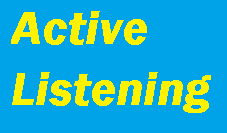 Most people have heard the term “active listening,” but there is a lot of misunderstanding about what it means. Some people have the impression that the skill is characterized by gestures, facial expressions and other non-verbal communication tactics that convince the speaker of the listener’s attention. This is much too superficial, though. Here are a few points on what active listing is, why it is important, and how you can get better at it.
Most people have heard the term “active listening,” but there is a lot of misunderstanding about what it means. Some people have the impression that the skill is characterized by gestures, facial expressions and other non-verbal communication tactics that convince the speaker of the listener’s attention. This is much too superficial, though. Here are a few points on what active listing is, why it is important, and how you can get better at it.
Active listening is the action of focusing entirely on the listening portion of a conversation, with the intentional effort to block out distractions that take away from the listener’s ability to receive and process. Put simply, it is a focused effort to receive the message the speaker is sending.
The skill is important in that it makes communication more effective and efficient. The messages are being conveyed completely and accurately and there are no misunderstandings. We all want to understand and be understood, and active listening makes it possible.
Here are a few common obstacles to active listening and ways to avoid falling victim to them.
Choose the Right Time and Place: Some conversations need to be held in a place where complete attention can be given by all parties. The more important and detailed the conversation, the more likely that time and place-planning will help. A quiet, distraction-free environment can make all the difference.
Have a Goal: Conversations that are driven by a goal will be more productive. If you, as a supervisor, need to speak with a subordinate employee about something important, take a moment to jot down what you need to know and formulate a few questions that will help you get the information you need.
Turn Off Brain Chatter: Have you ever been speaking with someone when you realized you missed what she said because your brain went somewhere else? Awareness of this phenomenon can help you reduce it. Practice turning off the self-talk so you can focus on what’s being said. Don’t allow yourself to fall in the trap of “waiting for my turn to speak.”
Ask Questions to Learn More: Ask for clarification. Ask for more detail. Engage in genuine conversation by asking questions, and listen while and until the other person finishes the thought.
Recap: After you have heard what you thought you heard, summarize by saying, “If I understood you properly, you said…” If you can paraphrase what you heard in this way, it will be clear that you were listening well. Communication and team cohesiveness will both benefit.
Active listening takes effort, but it is worth it. Better communication, greater efficiency, and fewer communication breakdowns are just the beginning. Try these tips and let us know how it works for you.
—
Learning Dynamics offers many engaging training programs that teach these and other communication skills. Contact Learning Dynamics today for a complimentary consultation.